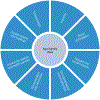Rethinking the urban physical environment for century-long lives: from age-friendly to longevity-ready cities
- PMID: 35937461
- PMCID: PMC9355489
- DOI: 10.1038/s43587-021-00140-5
Rethinking the urban physical environment for century-long lives: from age-friendly to longevity-ready cities
Abstract
In response to increasing life expectancies and urbanization, initiatives for age-friendly cities seek to facilitate active and healthy aging by strengthening supports and services for older people. While laudable, these efforts typically neglect early-life exposures that influence long-term well-being. With a focus on the urban physical environment, we argue that longevity-ready cities can accomplish more than initiatives focused solely on old age. We review features of cities that cumulatively influence healthy aging and longevity, discuss the need for proactive interventions in a changing climate, and highlight inequities in the ambient physical environment, especially those encountered at early ages, that powerfully contribute to disparities in later life stages. Compared with strategies aimed largely at accommodating older populations, longevity-ready cities would aim to reduce the sources of disadvantages across the life course and simultaneously improve the well-being of older people.
Conflict of interest statement
Competing interests The authors declare no competing interests.
Figures



References
-
- Riley JC Estimates of regional and global life expectancy, 1800–2001. Popul. Dev. Rev 31, 537–543 (2005).
-
- United Nations, Department of Economic and Social Affairs, Population Division. World Population Ageing 2019 Report No. ST/ESA/SER.A/444 (United Nations, 2020).
-
- World Health Organization. Global Age-friendly Cities: A Guide (World Health Organization, 2007).
-
- Buffel T, Handler S & Phillipson C Age-Friendly Cities and Communities: A Global Perspective (Policy Press, 2018).
Publication types
MeSH terms
Grants and funding
LinkOut - more resources
Full Text Sources

